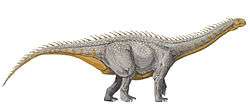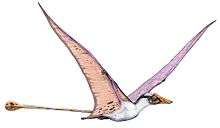Kota Formation
| Kota Formation Stratigraphic range: Early Jurassic to Early Cretaceous | |
|---|---|
| Type | Geological formation |
| Location | |
| Region | South Asia |
| Country |
|
| Extent | Telangana |
The Kota Formation is a geological formation in India. The dates for the Kora Formation are uncertain, but it dates from the Early Jurassic to Early Cretaceous, and is split into a Lower Member and Upper Member[1]. The lower members is though to be Hettangian-Pliensbachian[2].
Paleofauna
Vertebrate paleofauna
Indeterminate thyreophoran remains geographically present in Andhra Pradesh State, India. These were given the name Andhrasaurus by Roman Ulansky in 2014.[2]
| Ornithodires reported from the Kota Formation | ||||||
|---|---|---|---|---|---|---|
| Genus | Species | Location | Stratigraphic position | Material | Notes | Images |
|
B. tagorei[2] |
Geographically present in Telangana State, India.[2] |
"Scattered remains of more than [six] partial skeletons without skulls, manus, or pes."[3] |
| |||
|
C. indicus[4] |
Geographically present in the Chanda District of Deccan India.[4] |
|||||
|
D. indicus |
"Proximal pubis."[5] |
.[2] | ||||
|
K. yamanpaliensis[2] |
Geographically present in Telangana State, India.[2] |
"Nearly complete skeleton without skull."[6] |
||||
| Mammaliaformes reported from the Kota Formation | ||||||
|---|---|---|---|---|---|---|
| Genus | Species | Location | Stratigraphic position | Material | Notes | Images |
|
B. dattai[1] |
||||||
|
Kotatherium[7] |
K. haldanei[7] | |||||
|
Indotherium[8]. |
I. pranhitai[8] | |||||
Invertebrate paleofauna
| Insects of the Kota Formation[9][10] | ||||||
|---|---|---|---|---|---|---|
| Genus | Species | Location | Stratigraphic position | Material | Notes | |
|
Kotaphialtites |
K. frankmortoni |
Geographically present in Andhra Pradesh State, India. |
An ephialtitid hymenopteran. | |||
|
Taschigatra |
T. bharataja |
Geographically present in Andhra Pradesh State, India. |
||||
|
T. tulyabhijana |
Geographically present in Andhra Pradesh State, India. |
|||||
|
Xyelula |
X. alexandri |
Geographically present in Andhra Pradesh State, India. |
||||
See also
References
- 1 2 3 Prasad GVR, and Manhas BK. 2007. A new docodont mammal from the Jurassic Kota Formation of India. Palaeontologia electronica, 10.2: 1-11
- 1 2 3 4 5 6 7 8 9 Weishampel, David B; et al. (2004). "Dinosaur distribution (Early Jurassic, Asia)." In: Weishampel, David B.; Dodson, Peter; and Osmólska, Halszka (eds.): The Dinosauria, 2nd, Berkeley: University of California Press. Pp. 534–535. ISBN 0-520-24209-2.
- ↑ "Table 13.1," in Weishampel, et al. (2004). Page 263.
- 1 2 3 Wellnhofer, Peter (1991). "Summary of Lower Jurassic Pterosaurs." The Illustrated Encyclopedia of Pterosaurs. London, UK: Salamander Books Limited. p. 79. ISBN 0-86101-566-5.
- ↑ "Table 4.1," in Weishampel, et al. (2004). Page 78.
- ↑ "Table 13.1," in Weishampel, et al. (2004). Page 261.
- 1 2 Datta PM. 1981. The first Jurassic mammal from India. Zoological Journal of the Linnean Society of London, 73:307-312
- 1 2 Yadagiri P. 1984. New symmetrodonts from Kota Formation (Early Jurassic), India. Journal of the Geological Society of India, 25:514-621
- ↑ Mostovski M.B., Jarzembowski E.A. 2000. The first brachycerous flies (Diptera: Rhagionidae) from the Lower Jurassic of Gondwana. Paleontological Journal 34 (Suppl. 3): 367-369.
- ↑ Rasnitsyn A.P. 2008. New hymenopteran insects (Insecta: Vespida) from the Lower or Middle Jurassic of India. Paleontological Journal 42 (1): 81-85.

